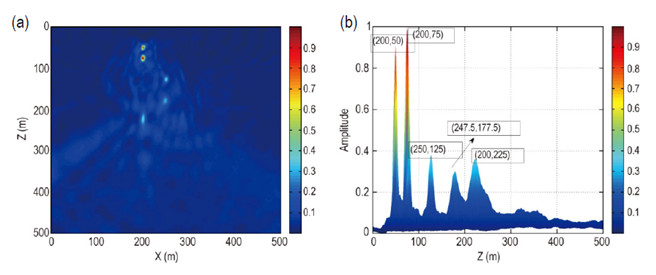In recent years, as more low-permeability oil and gas fields are exploited increasingly, hydraulic fracturing has become the production method for such oil and gas fields. Microseismic monitoring is a geophysical technique that images the location and distribution of fractures with weak seismic waves induced by hydraulic fracturing.
Source location is critical for microseismic monitoring. Since microseismicity records always involve low signal-to-noise ratio (SNR) data and large datasets, imaging or migration-based microseismic location methods have been developed using concepts from reflection seismic exploration.
Recently, researchers from the Institute of Acoustics (IOA), Chinese Academy of Sciences expanded seismic interferometric imaging method to elastic wave interferometric imaging, and proposed weighted-elastic-wave (WEW) interferometric imaging for microseismic source imaging.
The principle of seismic interferometric imaging for source location was firstly analyzed, and then multiple imaging solutions based on cross-correlograms of different wavefields and components were pointed out.
In most cases, the S-wave energy of real microseismic data was stronger than that of P-wave energy. So small correlation values corresponding to traveltime differences of P-wave from every two traces were eliminated. It meant a weighting coefficient W = [1, 0, 1, 1] was multiplied into the term of traveltime differences. This imaging method was defined as WEW interferometric imaging.
And there were also specific situations in which the P-wave energy was equivalent to or stronger than the S-wave energy. To ensure the high precision and resolution of the source location, different imaging solutions or weighting coefficients could be chosen according to the characteristics of the microseismic data.
A simple 2D numerical experiment using a horizontally layered isotropic model was conducted to test the stability and reliability of the WEW interferometric imaging method. Factors, such as noise, receiver spacing, velocity model, and number of sources were investigated. The traveltime differences of individual wavefields from different sources were independent, thus the WEW interferometric imaging method might be used to locate multiple sources.
Fig. 1 showed the normalized WEW interferometric imaging amplitudes of five continuously excited sources monitored with a surface array. The maximum error of the single direction was only 2.5 m (one grid spacing).

Fig.1 Profile (a) and positive X-axis view (b) of the weighted-elastic-wave interferometric imaging results (Image by IOA).
The proposed WEW interferometric imaging method improved the precision and eliminated artifacts in location profiles. It could deal with low-SNR microseismic data with velocity perturbations as well as relatively sparse receivers, and still maintain relatively high precision despite the errors in the velocity model.
Furthermore, it was more efficient than conventional traveltime inversion methods because interferometric imaging did not require traveltime picking.
Numerical results using a 2D fault model also suggested that the WEW interferometric imaging could locate multiple sources with higher location precision than the time-reverse imaging method.
This research was supported by the R&D of Key Instruments and Technologies for Deep Resources Prospecting (No. ZDYZ2012-1) and National Natural Science Foundation of China (No. 11374322).
Reference:
LI Lei, CHEN Hao, WANG Xiuming. Weighted-elastic-wave Interferometric Imaging of Microseismic Source Location. Applied Geophysics (Vol. 12, No. 2, pp. 221-234, June 2015). DOI: 10.1007/s11770-015-0479-z
Contact:
CHEN Hao
Institute of Acoustics, Chinese Academy of Sciences, 100190 Beijing, China
Email: chh@mail.ioa.ac.cn


